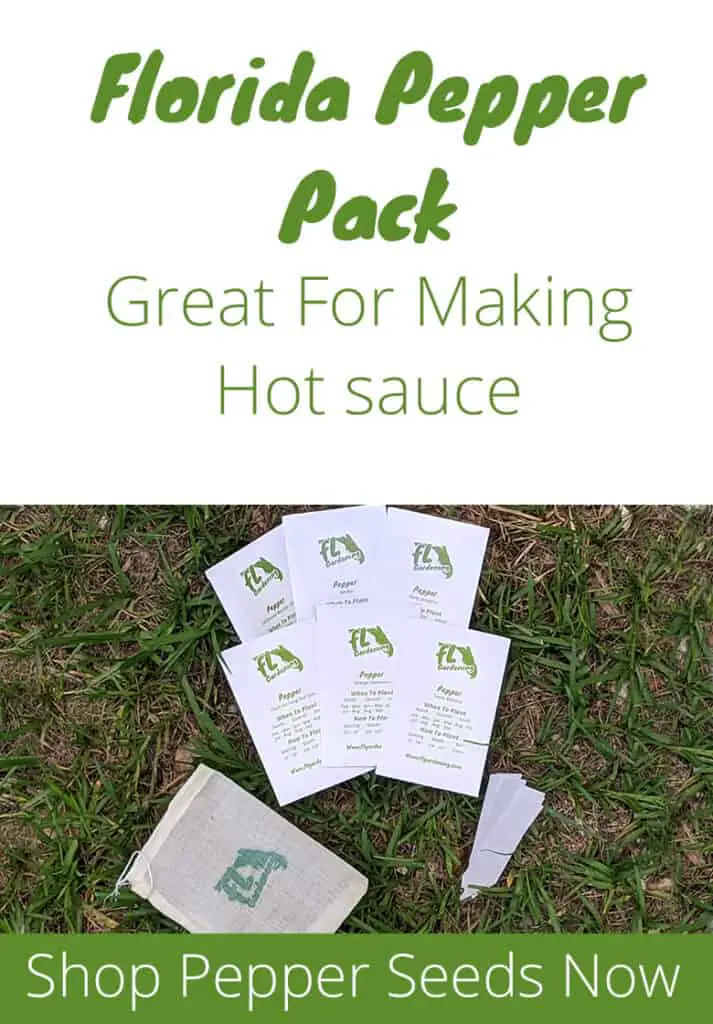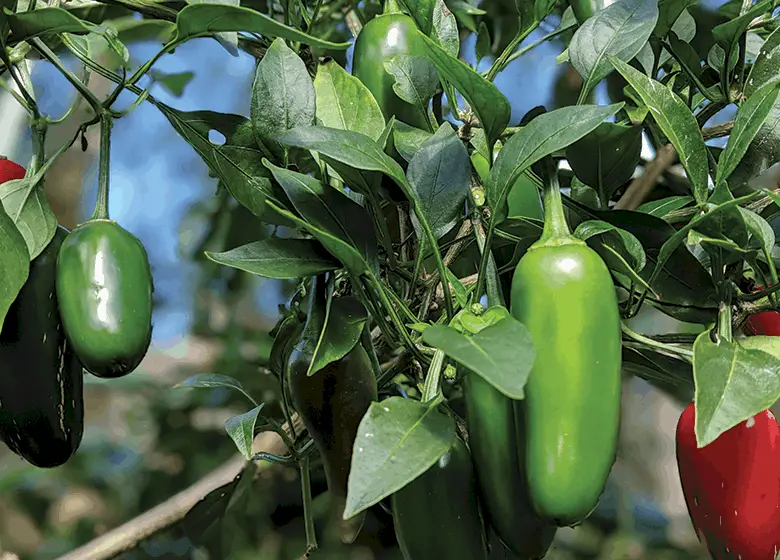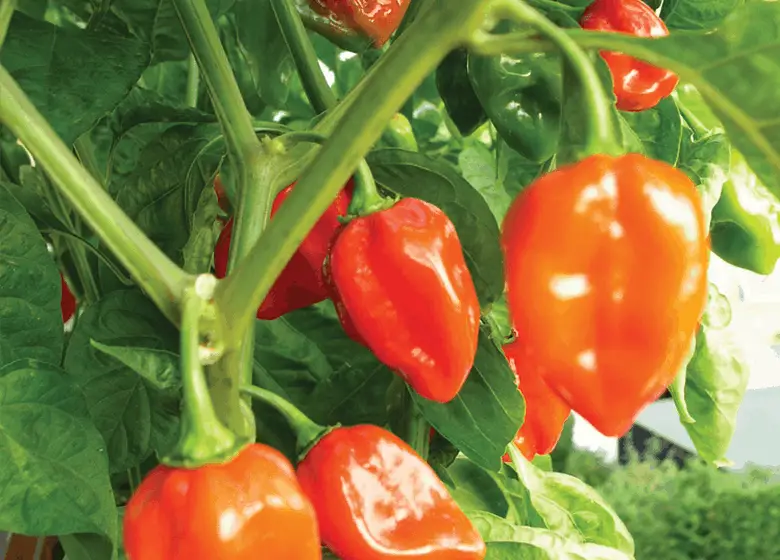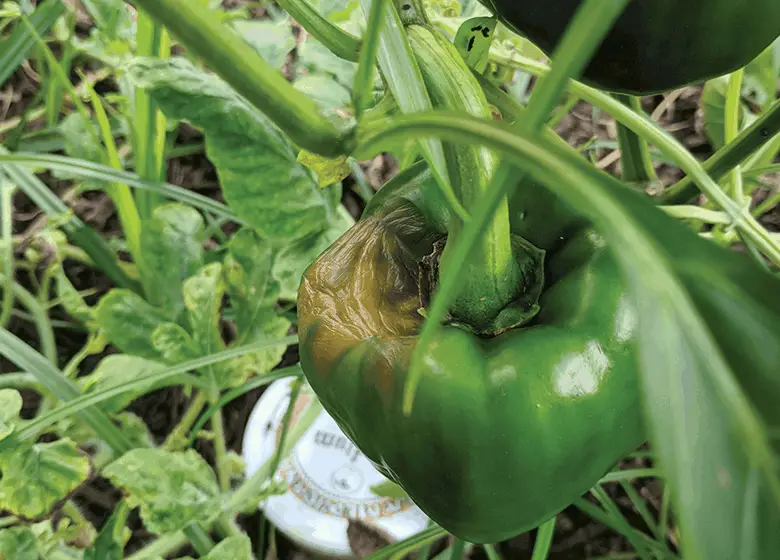Who wouldn’t want to grow peppers? They add a spice to the kitchen and are also beautiful plants. But can they grow in Florida?
Peppers Love the warmth and humidity that Florida has to offer. I’ve had good luck growing a few peppers off of this list and the rest of the internet seems to think that all of these peppers will easily grow in Florida.
The easiest peppers that you can grow in Florida
- Jalapeno Peppers
- Banana Peppers
- Chille Peppers
- Habanero Peppers
- Ghost Peppers
- Bell Peppers
- Thai Peppers
- Cayenne Peppers

There are different varieties of some of these peppers. Jalapenos for instance, have a few different options. I’ve always had great luck with the ‘Early’ variety, but there are a few others that will grow well here in Florida.
Read on to find out specific varieties that are Florida friendly and planting times.
Florida Friendly Peppers
Jalapeno Pepper
I’ve had the greatest success when gorwing jalapenos in my garden, compared to any other other pepper. They produce loads of peppers, sometimes more than I know what to do with.

Florida Friendly Varieties: Early Jalapeno, Jalapeno M, Jalapeno Fooled You
The last variety listed, Jalapeno Fooled You, is a heat free variety. It’s more of a sweet pepper than a spicy one. Kinda cool but I prefer the spice.
My garden grown jalapenos are so much spicier than anyone that I’ve ever bought in the store. I haven’t tried making a sauce out of them yet but my
Banana Pepper
Banana peppers get their name because the most popular ones looks kind of like a banana. They are a pale green, almost yellow color and they are long with a slight bend to them.
Banana peppers aren’t all the same though. They can range in color as they ripen, as well as heat level . Some banana peppers are sweet while others are spicy. It all depends on the variety that you purchase.
Florida friendly varities: Sweet Banana, Blazing Banana, Hungarian wax peppers
Sweet banana peppers are obviously sweet while blazing banana peppers are obviously hot. Hungarian wax peppers are also hot, their name didn’t give it away though. Hungarian wax peppers also
Chile Pepper
The chile pepper, also known as the chili pepper, is really a large family of peppers that can ecncompse most of this list.
But, there are distinct varieties of peppers that have chil in their name and grow really well in Florida so I
Florida friendly Varieties: Big Chile II, Biggie Chile Hybrid, Anaheim Chile
All of the chile peppers come in green and turn red as they ripen. They are mildly spicy, soming in at 500-100 on the Scoville scale.
Habanero Pepper
Habanero peppers are one of the spicier peppers that you can grow in Florida. It ranges any where from 100k-350k on the Scoville scale. Lately, it’s been a popular ingredient for lots of hot sauces and other spicy dishes.
Florida Friendly Varieties: Habanero, Caribbean Red

The black habanero is a unique variety that produces larger, deep maroon/ brown colored fruits. Normally habanero peppers will form green fruits and turn orange as they ripen and are ready for harvest.
Ghost Pepper
These peppers, like habaneros, have been trending in lots of sauces and spicy dishes lately. Ghost peppers, are also known and Bhut jolokia, originated from northeast India and at one point was the worlds hottest pepper.
It comes in at a little over 1 million on the Scoville scale, making it the spiciest pepper on this list.
Florida friendly varieties: Red Bhut Jolokia, Yellow Bhut Jolokia, Peach
Bhut
The Red Bhut Jolokia is the most common ghost pepper and the one that is probably in most sauces and dishes. There are many other kinds though that offer slightly different flavors and heat levels.
Bell Pepper
I’m going
Florida friendly varieties: California Wonder, Red Knight, Big Bertha
I’ve always tried the California Wonder variety, so maybe I need to switch it up and try one of the others. According to others

They are not spicy at all and if I could grow them would save money on my grocery bill! It’s one of the most common peppers. The fruits start off
Thai Pepper
This is a very beautiful pepepr plant. There aren’t a bunch of varieities of this partiucular plant. It’s known as the hot thai chilli pepper or even as an ornamental Thai pepper.
This plant grows compact, usually about 18″ tall and produces very small peppers that are about 1″ in length.
They come onto the plant as green peppers, and are definitely edible at this point. But, if you would like a spicier pepper wait until they turn red.
Cayenne Pepper
The cayenne pepper might be the most popular option when it comes to making hot sauces and dried pepper spices.
Florida friendly varieties: Long Thin Cayenne, Long Purple Cayenne, Ring Of Fire, Dragon Cayenne
These are moderatly spicy peppers, coming in at 30k-50k on the Scoville scale. Like most other peppers on this list they come in green and ripen to red.
Cayenne peppers are a classic garden vegetable that is versatile and easy to grow.
When Do I Plant Peppers In Florida?
Peppers are a heat loving plant. Good thing Florida has plenty of that to offer. In south Florida and some parts of central Florida you can grow peppers year round. In north Florida the cool weather will kill your plant back.
The best time to plant peppers is in the spring time after the threat of any frost is gone.
- North Florida: March – July
- Central Florida: February – September
- South Florida: February – September
These dates are just guidelines. They are based on the average date of last frost. So keep in mind that you may have to wait longer some years.
If you had a particulally cold winter you and are living in central Florida, you may have to wait until march to get your peppers into the ground.
Peppers hate cold, so you must make your decision on when you think there is no more threat of cold weather rolling in.
Direct Sow Or Transplant?
You can always start your peppers early in starter trays to get a head start and escape any threat of frost.
You can get a cheap starter tray (Check price on Amazon) and start lots of seeds indoors about a month or so earlier than you will be ready to plant.
I usually avoid transplanting because I never have good luck with transitioning the plants into the garden.
You have to “harden off” your seedlings before putting them directly into the garden. This is basically easing them into the natural elements.
They were living that Kush life. They had A/C and part shade.
Imagine getting that ripped away from you suddenly. Your plants hate it so much that often times they die if you don’t ease them in.
Start out giving them a few hours in the morning and increase the amount of sun they get everyday by a few hours. I’ve never been very good at this technique so I usually just plant right into the ground or buy transplants. For me, I like to remove the headache of hardening off plants and take the easy way out.
Best Location To Plant Peppers
For peppers to produce a good amount of fruit they will need full sun. This means at least 8 hours.
Scan your property and take into account anything that would block the sun. Things like large trees, buildings, or bushes. And keep in mind that the sun moves a lot throughout the year.
One part of your yard may get full sun in February but in a few months that same spot may be getting shaded out.
It might be just me, but before I started gardening I never paid attention to how much the sun moves in our sky.
For us in the northern hemisphere, As we head towards summer the sun will climb north through the sky. When we head towards winter the sun will descend south through the sky.
The winter solstice marks the farthest point south that the sun will travel and the summer solstice marks the furthest point north that the sun will go.
Best Soil For Peppers
Peppers aren’t super picky about the soil they are put in. This doesn’t mean that you won’t get better results with better soil. Having a good soil is one of the most important things to have.
If you are planting right into your backyard or the common Florida soil you should at the very least add compost and a think layer of mulch.
A good bag of any old gardening soil from your local nursery will be just fine for peppers.
I have some raised beds and when first filling my beds I always build a mix with these ratios:
- 40% Peat moss (Check price on Amazon)
- 40% Compost (You can get it on Amazon but I’ve found it way cheaper at local stores)
- 20% perlite (Check price on Amazon)
- Worm castings (Check
price on Amazon) - Mykos (Check price on Amazon)
You can replace the peat moss with coco coir if you would like. Coco coir is more environmentally friendly and doesn’t alter your soils PH like peat moss does.
Mykos is a beneficial
How To Fertilize Peppers
It’s best to add a well rounded fertilizer when you plant our peppers. Something like this 2-5-3 from Jobe’s (Check price on Amazon) is perfect. You can find this at most local nurseries. However if you can’t find this exact one that is fine.
Each nutrient in the fertilizer does something different for the plant. the three numbers represent the N-P-K value.
Nitrogen(N) helps the plant grow green leafy growth. Phosphorus(P) helps the plant develop flowers and fruit. Potassium(K) is a good all around health booster for the plant.
So, having a fertilizer that doesn’t focus on nitrogen is great for fruit producing plants. Anything you can find that has a lower first number and a higher second two numbers is just fine.
Harvesting Peppers
Sweet peppers usually take 60-90 to be ready for harvest. Hot peppers usually take a little bit longer, some can take up to 120 days to be ready for harvest.
Peppers like the bell pepper and the jalapeno are ready for harvest when they are green. You can wait to pick bell peppers until they are red if you would like a sweeter pepper.
Harvest ghost peppers, chile peppers, Cayenne peppers and Habanero peppers after a color change has happened.
Growing Peppers In Florida
Growing peppers in Florida is easy.
- Plant Florida friendly varieties of peppers.
- Plant in the early spring in all parts of Florida. Make sure there is no threat of frost, peppers hate cold weather.
- Peppers aren’t picky about soil but it never hurts to give them some compost and a nice layer of mulch.
- Pepper plants need 8 hours of sun to be productive.
- Fertilize with something like a 2-5-3 or a 5-10-10
- Harvest sweet peppers 60-90 after planting and hot peppers 100-120 days after planting.
